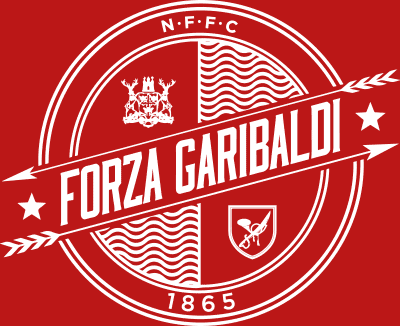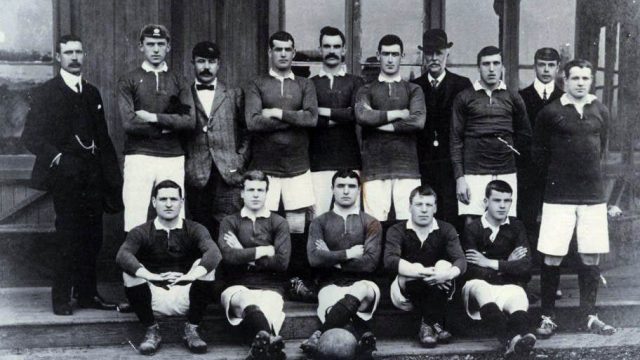El Rojo: The Influence of the Original Reds
The early years of Nottingham Forest contained many notable achievements. This fledgling football club wasn’t even the first in its own city and was not an early member of the Football League but it was integral to the evolution of the game.
Forest and a catalogue of dynamic individuals attached to it helped shift football forward from an often barbaric and hectic sport to one that placed emphasis on finesse and positive rule changes.
The influence of The Foresters in football’s infancy is most impressive. On the grass and off it they were trendsetters; a club that others looked to and modelled themselves on.
One obvious and very visual example of this is the choice of red as the team’s primary colour. Garibaldi Red to be precise.
In the decades that followed others came to wear that same scarlet uniform, some which can be traced back to Nottingham’s Original Reds.
Arsenal, England – Formed 1886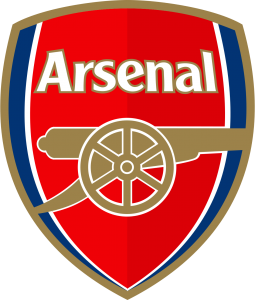
This story is widely known although it perhaps isn’t the narrative many of us think it is.
Upon their formation in 1886 Dial Square FC were gifted a set of Garibaldi Red shirts by Nottingham Forest, by that stage a club with twenty-one years of history. Indeed, Arsenal’s website states this as their official version of history.
There are a few different names credited as founders of Dial Square FC including Fred Beardsley and Morris Bates who both hailed from Nottingham. But it is Beardsley who seems to be widely acknowledged as the key driving force. Beardsley and Bates had played for Forest in the years leading up to their arrival in London looking for work.
Beardsley was a goalkeeper who, according to the Ken Smales Official Statistical History of NFFC made his debut for the Foresters against Darwen at Trent Bridge in 1880/81, a 3-0 win in front of 500 people. He featured intermittently over the following seasons only really establishing a starting role in the 1884/85 campaign which was his last full season and most likely the point where he headed south.
Dial Square was the factory where Beardsley and Bates found employment in London. This was part of The Royal Arsenal in Woolwich where armaments were manufactured. With no football club in the immediate area and both Beardsley and Bates eager to continue their involvement with the sport, Dial Square FC were formed.
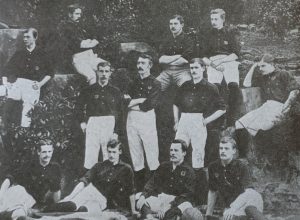
The Forest Squad of 1884-85 including Fred Beardsley (front row, far right)
Unlike many clubs of the time that were formed by often wealthy individuals, Dial Square FC had little financial backing and so, according to the official Arsenal version, Beardsley and Bates sought assistance from their former club:
‘‘Forest had a stash of unused uniforms for their team and they decided to ship them down to London. They also sent a ball for good measure.’’
Dial Square remained in deep red jerseys through their subsequent name changes from Royal Arsenal to Woolwich Arsenal and finally The Arsenal. This was until 1933 when manager Herbert Chapman decided to adopt the white sleeves associated with a modern day Arsenal shirt.
The first recorded meeting between Nottingham Forest and the team then known as Royal Arsenal was a friendly encounter in London in December 1892. Forest won 3-2. The following season they met again in London in April 1894, this time against the newly named Woolwich Arsenal in a 3-1 victory for Forest. Months later Woolwich Arsenal recorded their first victory with a 3-2 home win in September 1894. The regularity of the games between two clubs not geographically close may be due to a lack of other opposition in football’s early years or maybe as a sign of the bond that continued between the clubs. In the 1905/06 season Woolwich Arsenal joined Forest in the First Division.
One hundred years later in 2005/06 Arsenal opted to return to their original colours to mark their final season at Higbury. They wore a special edition kit based on the kit that Forest had provided in 1886.
What has since puzzled me is that the burgundy kit Arsenal wore in 2005/06 bears little resemblance to the Garibaldi Red that Forest sported. Or indeed what Garibaldi’s red shirted armies wore.
So why did Arsenal think that the shirt Forest gifted them was so dark? Perhaps Arsenal changed colours early on in their history to this darker alternative although there is nothing to suggest this happened.
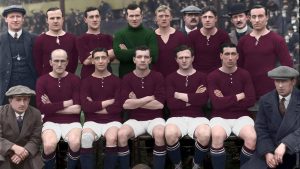
The 1913 photo Arsenal based their 2005 special edition burgundy kit on. A possible mistake.
Quite simply, it seems very possible that Arsenal cocked up in 2005.
Their ‘currant red’ shirt was based on a single photo from 1913 which clearly shows Arsenal in a similar colour to their 2005 special edition shirt. Except there are various dissenters including Mark Andrew and Andy Kelly, the creators of thearsenalhistory.com, who suggest that Arsenal wore Garibaldi Red and never this darker version. As for the image itself, camera technology was such at the time that the colour red was problematic to capture. One consequence was it made a standard red become much, much darker in the physical photograph.
You may be familiar with the story of Forest wearing the white shirts of Derby in 1898 after the FA Cup win for their team photograph with the trophy. This was because red was not easily captured on film.
The following is an extract from HistoricalKits.co.uk which suggests a similar issue created the confusion at Arsenal:
‘In June 2005 the club announced that they would play in dark “red currant” jerseys for one season to mark their last season at Highbury. The marketing campaign asserted that the colour was based on the dark, plum coloured shirts worn when the team moved to north London, with a poorly colourised team photograph from the period in support. With help from Mark Andrews and others, HFK is now convinced that there is no truth in this story and the team has always worn bright red shirts. The dark appearance of their early tops is due to the photographic emulsions in use at the time, which were over sensitive to red light.’
It is quite possible therefore that Arsenal went through an entire season wearing a kit in celebration of a kit that never existed. Like Forest, Arsenal it seems only ever wore Garibaldi Red.
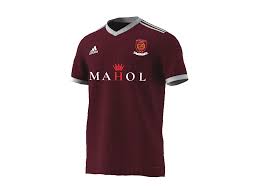
The home shirt of new club Dial Square FC for the 2020/21 season
Despite this, one group of Arsenal fans are taking the burgundy strip as historically correct. Having become disenchanted with modern Arsenal and the growing commercialisation of the club they will enter Dial Square FC into the football pyramid as an alternative offering for the 2020/21 season. Their strip will be based on the same dark red used in 2005.
Mark Andrew from ArsenalHistory.com does also throw some doubt on the physical gifting of the kit by Forest to Dial Square. Instead he believes that Arsenal’s founder, Fred Beardsley, simply decided to base his new team’s colour on his old team. Beardsley, however, certainly did not sever his Forest links, continuing to appear as a guest in cup competitions for The Original Reds through until 1889 while also representing his new side.
Still, there is little doubt that Arsenal F.C are of the opinion that Forest did provide the shirts. An ornamental cannon sits in the Forest board room, gifted by The Gunners as an acknowledgement of the strip that Forest provided in 1886.
Whatever the truth, it is clear that Forest were not just the inspiration behind Arsenal’s colours but a fundamental part of their very existence. Without Nottingham Forest there would very possibly be no Arsenal.
And the spread of Garibaldi Red in this chapter does not end here. In 1906 the president of Sparta Prague visited London and was suitably impressed by the Arsenal attire. Sparta changed their colours and wear a version of Garibaldi Red still to this day.
Furthermore a 2005 article in The Guardian ties the colours of Ajax and Portugal’s Sporting Braga back to Arsenal. Making them both possible further descendants of the Original Reds.
Club Athletico Independiente, Argentina – Formed 1905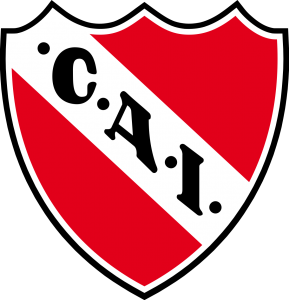
In 1905 Nottingham Forest became only the second English side (after Southampton in 1904) to visit Argentina having accepted an invite from the Argentinian FA. They were paid a fee of £200 for the visit.
The journey from Southampton departed on 19th May 1905 and took three weeks via boat. Forest initially arrived in Montevideo, Uruguay and played their first game there against Penarol on 11th June 1905. Note that the accompanying image markets a ‘sensational’ game against the Uruguayan national side but this was an error.
During their South American tour Forest played eight fixtures against local opposition in front of crowds ranging from 1,500 to 10,000. They won them all scoring 57 goals and conceding only 3. Their ninth and final game was one between the travelling Forest squad in front of 3,000 spectators
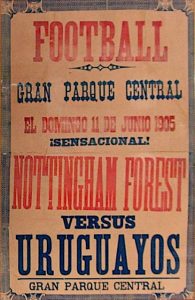
The ‘sensational’ game against Uruguay was actually to be against Penarol
Of importance here is the sixth fixture, a 6-0 victory over Alumni Athletic Club. In attendance that day at the end of June 1905 was the president of Independiente, Aristides Langone, who was immersed by the skill and the vibrant colour of the Forest side. Langone made the decision to propose a change from their original white and blue strip to red.
There are those that dispute this version of events. One Argentine website (laviseraweb.blogspot.com) casts doubt on the theory of Forest being involved in Independiente’s transition to red, arguing this was linked to the rise of socialism in Latin America. Another theory is that Langone was too young and not affluent enough to travel to the Alumni game against Forest, perhaps reading about the game instead and being influenced that way.
Still, there is much that does point to the original story holding truth. In a search for more information I spoke to Ian Tomas Dols, an Independiente supporter. Ian referred me to a
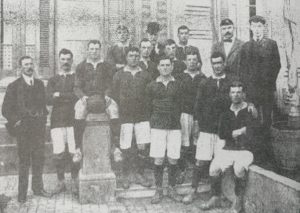
The Forest squad in South America on their 1905 tour. This image was featured in the Argentinian newpaper, La Nacion
1937 issue of a sports magazine named El Grafico which quotes Langone on his presence at the 1905 game:
‘’When I saw the Nottingham guys come onto the pitch I was impressed and liked the shirt. They looked like devils.’’
Ian believes the new red shirts were worn for the first time in 1907 but officially it is recognised their maiden appearance was for a 8-0 victory over Banfield on 10th May 1908. The resulting change to red shirts led to a new identity for Independiente. They would became known at ‘El Rojo’ which translates as ‘The Red’.
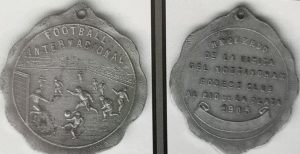
A medal was presented to each of the Forest players who toured South America
The change to red also serves to bring Independiente fans in touch with Nottingham Forest when exploring their heritage. Ian Thomas Dols was introduced to the story in 2010 when his father purchased a selection of English team shirts from eBay:
‘’I read about the story of Nottingham Forest and Independiente. I liked the story and especially the feat of having been promoted to the First Division and getting the title the following year. And then consecutively champions of the Champions League. It is a fact that has never been repeated in the world.’’
Ian says that many Independiente supporters are aware of Forest’s part in their history and that he himself has started to follow Forest’s progress and one day he hopes to be able to travel to England to see them play.
Nottingham de Almagro – Formed UNKNOWN but likely to be 1904/1905
In researching the history of Forest’s visit to Argentina in 1905 I discovered evidence of the bizarrely named Nottingham de Almagro. This club are extremely difficult to trace; virtually their entire online presence is related to a single game in 1906.
It seems that Nottingham de Almagro had British roots and their name would surely lend itself to their being a connection to Nottingham, England. Yet I cannot confirm this.
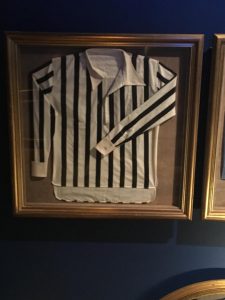
The shirt hanging inside Boca Juniors stadium with their original black & white colours
Almagro forms part of Buenos Aires and the Nottingham part appears to have no geographical connection to Argentina. What is known is that they played in black and white. Naturally, any link back to Nottingham, England may therefore be via Notts County or this could just be a coincidence. Maybe all of it is.
Nottingham’s colours nevertheless are interesting as they are said to have had a considerable part in shaping one of Argentina’s biggest clubs – Boca Juniors.
Boca and Nottingham de Almagro were local rivals and wore the same colours – vertical barcode stripes. The Notts County link resurfaces with a story from a friend who visited the Boca stadium in 2017. The stadium tour guide informed those present that the black and white shirt on the wall was one gifted by Notts County owing to Boca’s original colour. However, there is nothing that correlates and of the three Notts fans I enquired with on this they all believe this is not true.
The Nottingham de Almagro and Boca kit clash created problems logistically and from a tribal nature. The two teams therefore agreed to play each other in 1906 to decide who would keep the colours.
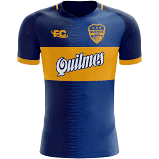
The 2020/21 Boca Juniors shirt
Nottingham de Almagro won 3-1 and Boca Juniors were forced into a change. Some time later representatives from Boca would visit the docks and decided that they would base their new colours on the flag of the next ship that arrived into port.
The next ship just so happened to be Swedish and the iconic blue and yellow Boca colours were born.
There is no written evidence to support this tale, it has been passed down via the generations and could therefore be whimsical folklore. Of more interest is the history of the Nottingham team who appear shrouded in mystery.
Perhaps there is some tenuous link between Forest or Nottingham folk influencing one of South America’s largest clubs via Nottingham de Almagro.
Even if I end up disappointed with the actual answer I’d love to know the true story.
OGC Nice, France – Formed 1904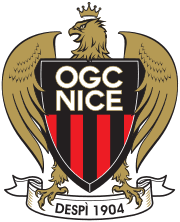
Forest, Arsenal and Independiente can all trace their colours back to a day in 1865. A meeting at the Clinton Arms public house in Nottingham. The fifteen founders of Nottingham Forest were inspired by Giuseppe Garibaldi, the Italian revolutionary, and his legions of Red Shirts.
In August 2019 we unveiled a plaque on the side of the Clinton Arms and I wrote an article on this meeting place for the fifteen and how Forest came to wear Garibaldi Red. You can read it here should you wish:
https://www.forzagaribaldi.com/1865-commemorative-plaque-unveiling-saturday-31st-august-2019/
One team certainly not inspired by Forest but that we are linked with through Garibaldi is OGC Nice. Late last year we received an e-mail from Bruno Martel who writes the QLV Dissata fanzine and is a Nice supporter.
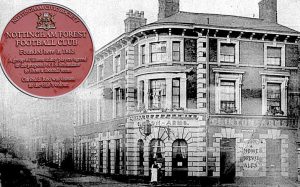
The Clinton Arms on Shakespeare Street in Nottingham
Bruno had learned of Forest’s link with Garibaldi and was keen to learn more while educating us on the iconic figure Garibaldi is in Nice.
By chance Bruno was visiting London in November 2019 at the same time Forest were at QPR. We were fortunate enough to meet him in a pub before the game and I was kindly gifted a Nice supporter t-shirt which carries Garibaldi’s image.
I asked Bruno to explain the link his club has with Garibaldi:
‘’To consider everything, you must know that Nice was the last city to become French in 1860.
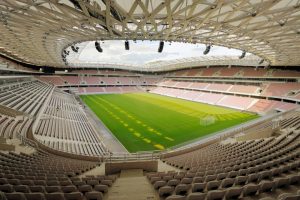
The Allianz Riviera Stadium opened in 2013 includes a stand named after Giuseppe Garibaldi
Giuseppe Garibaldi was born in Nice in 1807, and during all his life, he is still linked to the city. Often, after all his “trips” or war campaigns, he came back here.
In 1860 before the “annexation” of Nice by the French, he was deputy of Nice, and he was opposed to the attachment to France. He tried to fight against but didn’t succeed. This episode, his love for Nice and the revolutionary aspect of his life, I think that’s why people in Nice love him. We can talk for hours about him; there are many books about his life.
Nowadays, we have a Garibaldi square with his statue and when we moved to our new stadium, fans were allowed to choose the name of the new stands. Two of them have been named according to historical figures of the city:

Nice fan Bruno Martel presented us with a Garibaldi t-shirt before the QPR game in Nov.2019
Catarina Segurana and Giuseppe Garibaldi.’’
Considering the above I admit I felt a little inadequate when Bruno asked me to explain Forest’s connection with Garibaldi. But the founders of NFFC were seemingly well versed with their knowledge and respect for Garibaldi and what he represented. To create their new football club in his colours was not only a nice homage but maybe a fitting link considering the pioneers Nottingham Forest would become in the years to come.
Until that conversation with Bruno I was unaware that Garibaldi had such a direct influence on other football clubs. It’s likely there are others out there too. Just as Forest’s Garibaldi Red most probably led to far more teams adopting those colours as their own.
Italy
Considering Garibaldi’s standing in Italy I had figured that there would be multiple teams in the Italian leagues donning his colours in tribute. The answer it seems, however, is there isn’t.
I asked Maurizio Volgarino of the ‘Robin Hood Reds’ Italian supporters group to assist my search but he too was unable to trace any football shirt links to Garibaldi. Something he felt was surprising. Maurizio did however point me in the direction of A.C Pisa of Serie B playing at the Stadio Arena Garibaldi.
Possibly the best link relates to AC Milan, famously formed by Herbert Kilpin of Nottingham, who declared ”our colours will be red like fire and black like the fear we will invoke in our opponents.” There is little to link Forest (or indeed Notts) directly to this but, well, it’t not too much of a leap to consider this as possible is it? Especially as he is said to have formed a youth team named Nottingham Reds Garibaldi in his adolescence.
Epilogue: The Garibaldi Trophy
Hopefully you have found this an interesting and perhaps educational read. It’s a rich tale that has Nottingham Forest at its heart and with many elements that surprised and delighted me. Some of these stories I thought I knew but didn’t, others were brand new for me. Plus there was the strange coincidence of much of the major points of the story centering in the period between 1904 and 1906.
Something tells me there is still more to be discovered too.
I’d like to conclude with an idea. For the recent 150th anniversary of NFFC there was much talk about exhibition matches with Malmo or Hamburg, teams forever associated with the pinnacle of our history. Sadly these did not materialise.
Could it be possible to unite the four main team mentioned in this article – Forest, Arsenal, Independiente and Nice – to compete in a pre-season tournament at The City Ground for a trophy named in Giueseppe Garibaldi’s honour? Alternatively I’m sure a fair few of us would be very interested in a jaunt to the south of France or Argentina if necessary!
This could maybe coincide with the opening of the redeveloped stadium or the upcoming anniversary of 125 years at The City Ground. Or maybe we don’t need a reason.
Perhaps we tell Arsenal that they owe us a favour, reach out to our Independiente brothers in red and surely there can be no better suited club to compete in Garibaldi’s honour than Nice. The Giuseppe Garibaldi Trophy does already exist in Rugby Union between France and Italy but it would surely be possible for football to develop its own version.
Football, as much as it is about winning, is also about heritage and friendship. Four football clubs with a rich history tied back to the colours of one Italian general.
A rather nice story I hope you agree.
Matt
With thanks to all those who contributed to this, especially Ian at Independiente and Bruno at Nice. I have created a list of references below for anyone who would like to do some further reading. I refer you in particular to the Q&A with Bruno Martel I did after the QPR game but never got around to publishing and also the Old Stadiums link which is a comprehensive guide on the 1905 South America tour from an Argentinian website. The detail on the tour and the history of Nottingham Forest is incredible and fascinating.
Bibliography
Angels With Dirty Faces: The Footballing History of Argentina, Jonathan Wilson
Arsenal History: http://www.thearsenalhistory.com/
Bruno Martel Q&A: https://www.forzagaribaldi.com/qa-with-bruno-martel-editor-of-ogc-nice-fanzine-qvl-dissata/
Dial Square FC: https://www.dialsquarefc.com/
EL Grafico (1937 hard copy magazine): https://www.elgrafico.com.ar/
Historical Kits: http://www.historicalkits.co.uk/Arsenal/Arsenal.htm
Forever Forest – 150 Years of the Original Reds book, Don Wright
La Visera: http://laviseraweb.blogspot.com/2008/05/1908-2008-100-aos-de-la-camiseta-roja.html
Nottingham Forest: The Official Statistical History book, Ken Smales
Old Stadiums: http://viejosestadios.blogspot.com/2020/03/la-gira-del-nottingham-forest-1905.html
